This year’s floral “Fireworks”, created from flowers, leaves, and grasses from Kris’ garden.
Celebrating the beauty of nature and our nation’s independence 🇺🇸🎆

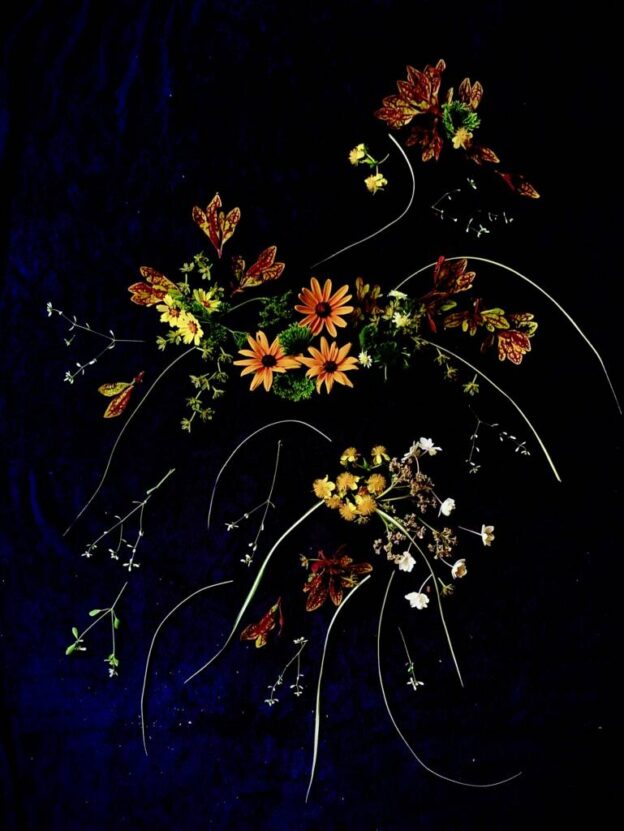
Early spring in Birmingham….the temperatures fluctuate up and down, and it’s still early to be planting the real heat lovers like caladiums and vinca in the ground – oh, but your fingers are itching to dig in the garden again…
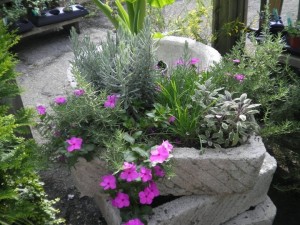
Trailing pink vinca works well with sun loving herbs of lavender, sage and chives in this trough planting….
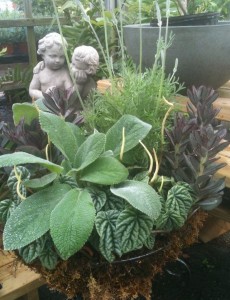
Here perennial lamb’s ear mixes with lavender, sedum and a pepperomia – (a common houseplant that also adds great texture…)
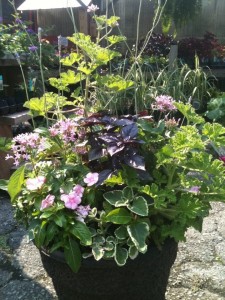
This combination for sun includes pentas, scented geraniums, vinca, purple basil, and variegated Swedish ivy meandering through the entire composition…
Happily, you can begin planning your summer container plantings, which can also be great springboards for future garden groupings – testing them in a pot first is a safe and fun way to experiment.
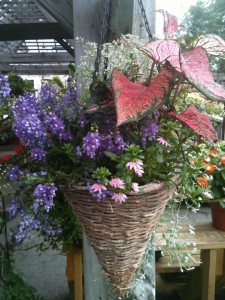
This hanging basket for sun includes a sun loving caladium, angelonia, pink fan flower, trailing silver dichondra, and an airy white euphorbia…
These pictures are container combos from seasons past – all lasted through the brutal heat of summer given water, deadheading and cutting back as necessary.
The old cliché of using a “thriller, filler and spiller” has been much used, (Maybe a little too much?) but don’t feel tied to it please! Designing creative plantings shouldn’t be absolute or bound by rigid rules.
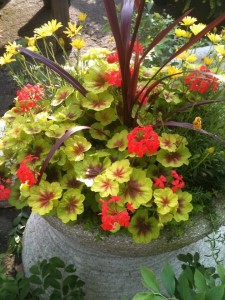
‘Indian Dune’s’ fancy leaf geranium, cordyline and thyme work in half day or full sun…
However, do try to combine plants that appreciate the same amount of light and water and have growing habits that compliment one another.
If you can do that, any plant combo you like within those parameters is fair game. There are many plants that will handle a lot of sun but still appreciate a little shade, especially in the afternoon, when the heat is the most brutal. Others will need partial to full shade in our climate. The important thing is to choose the right plants for whatever conditions you have.
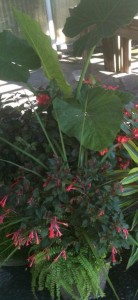
Elephant ears add drama, with a heat tolerant fuschia, ‘Gartenmeister’ and a trailing maidenhair fern – this one was planted with a shady area in mind…
The larger the container your space can accommodate the better! Not only will you be able to add more plants, but watering will be easier as well. Having said that, when maintaining large planters, if temperatures are in the 90’s every day and lows don’t get below the 70’s at night (July and August in Birmingham!), be prepared to water every day, even if your planters are in only half day sun. Of course, there are always exceptions…succulents, purslane, portulaca – these are a few plants that can take dry soil and heat, but even they will need water eventually!
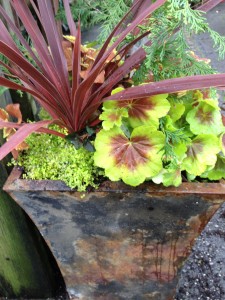
Cordyline, fancy leaf geranium, baby tears…morning sun and afternoon shade or filtered sun suit this planting…
Plant choices change weekly during the height of spring and it can be overwhelming…we’re happy to help you come up with the right combinations of plants for your containers if you’re unsure. Just be sure you know how much sun (or not!) they receive and the sizes of your planters, and we can take it from there.
Another tip: Flowers aren’t always what adds the most pizazz. There are great foliage choices out there, many that add color with no blooms at all. Some of the most striking planters are those done with just foliage – try it sometime!
If you follow us on Instagram or Facebook you’ve probably seen a new series of shop videos – if not, follow us and check them out! They’re also on our YouTube channel under Oak Street Garden Shop – if you’d like to see more, subscribe!
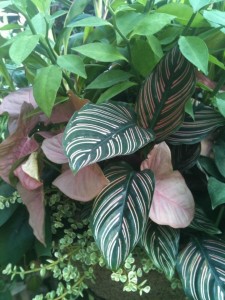
Foliage is as interesting as flowers!
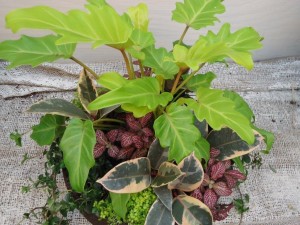
A shade planter – all foliage!
By Kris Blevons
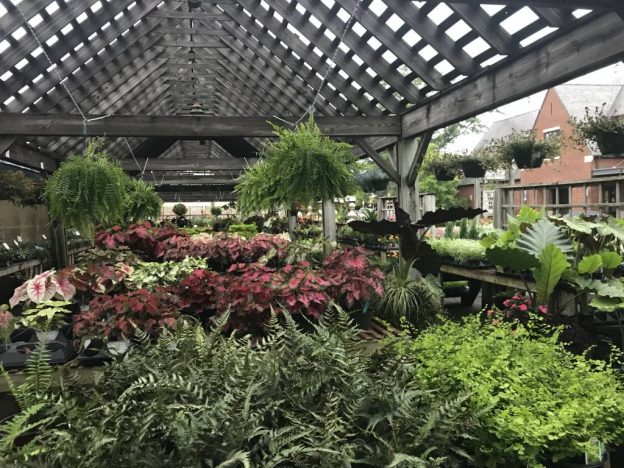
One cloudy morning right before a deluge of rain, the light was finally right to take a few pictures of the nursery. Usually the light is too bright, or we’re busy unloading trucks, helping customers, filling orders, and generally running around.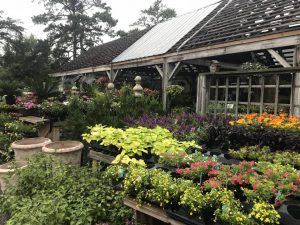
I’m certain the shots here would be better with a great camera (These are IPhone pictures.), but this gives you an idea of the amount of material still available, fresh plants from local growers ready to take on the midsummer heat.
Some of the best annuals for summer planting and filling in tough spots are vinca. They come in a range of colors and once established are extremely drought tolerant. Trailing varieties are also available.
Upright pentas are another workhorse of the summer and are butterfly favorites too. This is another that hybridizers have improved upon each year, and one that also has a trailing version, perfect for sunny containers.
We still have a selection of caladiums too, and the majority of them will tolerate sun as well as brighten shady spots in the garden. If you’ve ever looked at your garden beds and seen nothing but little leaves and a few blooms, caladiums might be just the thing to add that interesting and colorful foliage element to your design.
This year there’s a new begonia called ‘Canary Wing’ that’s been fun to play with in mixed containers, but it would also be stunning as a single specimen in a pot or massed in a shady garden bed. The red blooms on this large begonia contrast beautifully with the bright yellow leaves.
As you walk through the nursery, you’ll see a myriad of other choices including angelonia, a great bedding plant for sun. It’s best used in masses, and the spiky blooms add visual contrast when used with other blooming plants like lantana and vinca in sunny spots.
Silver dichondra adds its silvery sheen to plantings, cascading down the side of pots, over walls and between plantings. It’s a tough plant and drought tolerant too.
So, if you simply need a few fill-in flowers or have a larger area that still needs planting, we have plenty of healthy and beautiful choices for your garden. And, while you’re here, take a browse through the perennials and herbs and stroll through the greenhouse as well!
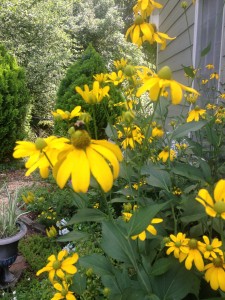
Rudbeckia ‘Herbstonne’
It’s July in Birmingham, time for weekends at the lake and trips to the beach or mountains (and aren’t we lucky to be so close to both?) So I promise not to make you work too hard in the garden… but remember, a little work now will mean less later – and a prettier garden too!
So, here are a few things to be thinking about – and you don’t even have to do them all at once! Simply walk through your garden at least every week and try to do at least a couple of the following tasks each time:
Pull weeds that may be coming up and dispose of them. Never put weeds on your compost pile unless you want more! Pulling weeds a bit at a time is so much easier than ignoring them and doing a marathon weed pull later. Trust me on this; I’ve been there. Did you see the post on mulberry weed? It’s one you need to keep out of your garden!

‘Becky’ daisies
Deadhead (cut off dead “heads” of blooms) any flowers that have passed their prime.
Along the same vein as deadheading is cutting back. Planters benefit greatly from being cut back when they are geting “out of control” in size (usually around this time of year if you planted them in the early spring). It’s a difficult thing to do for folks, but try it. Cut back those weedy looking zinnias. That coleus that’s gotten enormous? Cut it back! Those trailing plants that are looking a little worse for wear? Cut them back by at least half.
There, you did it! Now give those plants a bit of fertilizer, keep them watered, and then stand back while they flush back out. You can thank me later!
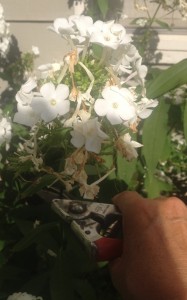
Deadheading a phlox bloom…
Perennials in your garden will also appreciate a little attention here and there. When your phlox has pretty much bloomed out, trim the spent flower head off. It will usually rebloom a second time. Once they’re completely done blooming, cut them back by half to neaten things up a bit. Rudbeckias, daisies and coneflowers will also continue to bloom longer if you pay attention and deadhead them just as you do your annuals.
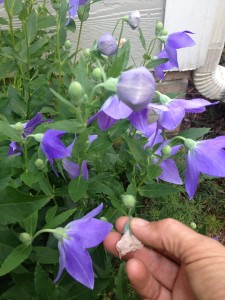
Deadhead individual blooms on balloon flower
Balloon flower is one perennial that you should never cut back while it’s blooming or you’ll lose out on a lot of flowers. Simply pinch off old blooms – this is best done daily. Confused about annuals and perennials? Refresh yourself by reading this post on them.
Do you see yellowing leaves on perennials or annuals? It only takes a few minute to “groom” a plant – simply remove the yellow leaves; after all, they’re not going to turn green again! Daylilys definitely look better if you pay attention to this after you’ve cut back the faded bloom stem. You can even cut their foliage back by half to neaten the plant up after it’s bloom period is completely over.
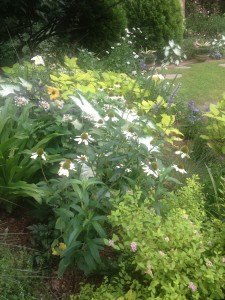
midsummer…perennials and annual share this bed.
Some late blooming perennials should be getting taller…inserting wide border supports keep them in line (They are one of my favorite support systems.). Take a look HERE if you missed the post on late blooming perennials and what to do with them early in the season. The Rudbeckia ‘Herbstonne’ shown in the picture at the beginning of this post is an example of a perennial I cut back in the spring to control it’s height and bloom time. They are in full bloom around town now.

See the mulch?
If you need to refresh mulch in beds, now is a good time to get this necessary task done. Not the most fun job, but it keeps the soil temperatures at the root zone of plants at an even temperature – especially important in our hot climate! Mulch conserves moisture, smothers weeds, and eventually will break down, contributing to the health of the soil too. Pretty good stuff all the way around.
Okay, that wasn’t so bad was it? Now you can pour yourself a glass of wine, pat yourself on the back and enjoy your beautiful, cared for landscape!
By Kris Blevons
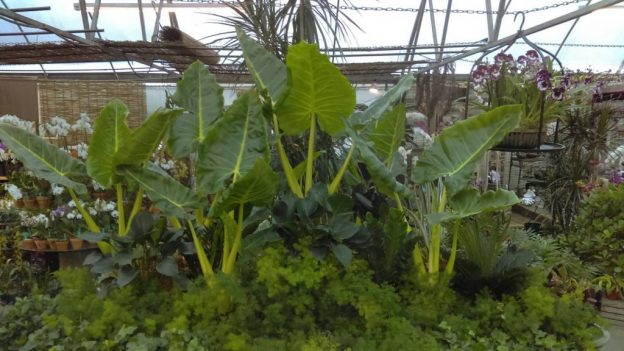
Bold and dramatic, the alocasias are one of the most elegant tropicals of the summer garden.
One look at the bright yellow stems of the showstopping giant Alocasia ‘Lutea’ rising at an angle upward can practically take your breath away. Mix it with darker green leaves and wispy foliage as a contrast and it’s unforgettable.
Alocasias are natives of Asia, from Sri Lanka and India through Southeast Asia to Indonesia. Keeping this in mind, Birmingham’s hot summer months are perfect for these giants from half a world away.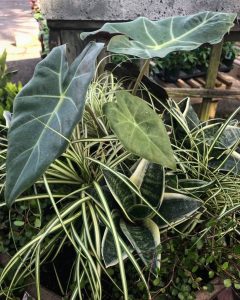
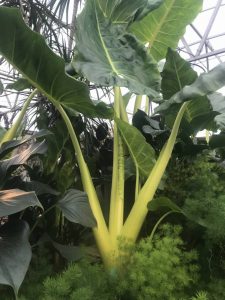 If I had to give a favorite cultivar of Alocasia, it would be a tossup between the darker veined cultivars like ‘Mayan Mask’ and the above mentioned ‘Lutea’. But any of them offer a dramatic and large leaf presence in the summer garden.
If I had to give a favorite cultivar of Alocasia, it would be a tossup between the darker veined cultivars like ‘Mayan Mask’ and the above mentioned ‘Lutea’. But any of them offer a dramatic and large leaf presence in the summer garden.
Offer them dappled sunlight (More sun is ok, but be very sure to keep them well watered.) and ample moisture for the best growth. As large a pot as is feasible for your space, or well amended rich soil, if you’re planting them in the ground, will keep them happiest through the hot summer months.
If you follow us on Instagram or Facebook you’ve probably seen a new series of shop videos – if not, follow us and check them out! They’re also on our YouTube channel under Oak Street Garden Shop – if you’d like to see more, subscribe!
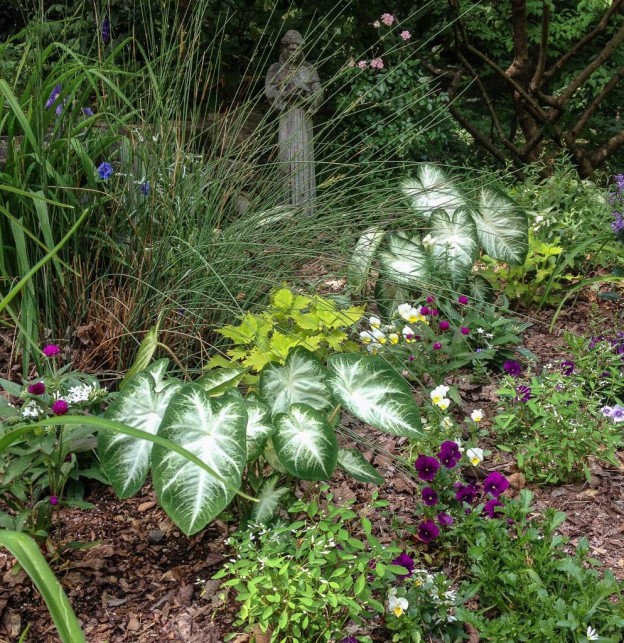
 I read a piece that Tony Avent of Plant Delights Nursery wrote a few years ago about some people being “controlling” gardeners while others are “gambling” gardeners. I really thought it was spot on, and I can say I’ve worked with both types.
I read a piece that Tony Avent of Plant Delights Nursery wrote a few years ago about some people being “controlling” gardeners while others are “gambling” gardeners. I really thought it was spot on, and I can say I’ve worked with both types.
Of course, many of us gamble each year, planting marginally hardy plants that have done fine with our mild winters of past years. Boy, can some winters give us a whammy though!
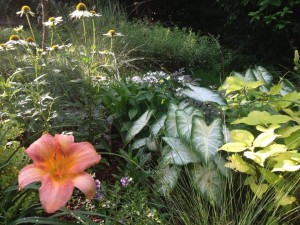
Annual caladiums, coleus and pentas are added to this perennial bed
I really liked this comment from Tony Avent, “Controlling folks want everything to work out just as the gardening books say, and struggle when plants don’t do exactly that, while the gamblers take a chance, try new things and hope for the best.
For the gamblers if things don’t work out quite as expected, it’s an opportunity for something new, rather than a failure. Personally, I like the gamblers approach to gardening much better, and think it causes a lot less anxiety! So, what’s the point? The point is to relax and enjoy gardening, remembering that nature is always in charge.
Life and death in the garden are no different than life and death outside the garden. Our options are to dwell on the sadness of death or celebrate the life that passed and embrace the next life that lies ahead.”
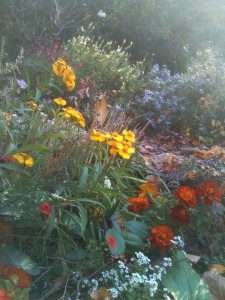 With the beginning of a new planting season, my personal outlook is going to be that of looking on my gardening efforts as a joy and an opportunity to not only beautify my landscape and surroundings but to nourish my soul as well; and, if there are failures, that will be part and parcel of the process. Some of my best plant combinations have been happy accidents!
With the beginning of a new planting season, my personal outlook is going to be that of looking on my gardening efforts as a joy and an opportunity to not only beautify my landscape and surroundings but to nourish my soul as well; and, if there are failures, that will be part and parcel of the process. Some of my best plant combinations have been happy accidents!
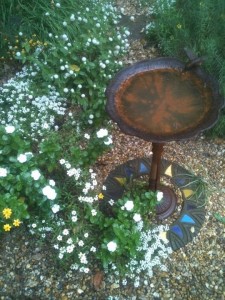 The pictures here are of my garden – plants are allowed to self seed, failures are yanked out, and plants that strike my fancy are tucked in here and there where I think they might look good. It wouldn’t make anyone’s list of a perfectly designed space, but it’s mine and that’s how you should treat yours too.
The pictures here are of my garden – plants are allowed to self seed, failures are yanked out, and plants that strike my fancy are tucked in here and there where I think they might look good. It wouldn’t make anyone’s list of a perfectly designed space, but it’s mine and that’s how you should treat yours too.
Above all, whatever the outcome of your garden, take time to appreciate the life you bring into it…a butterfly on a zinnia bloom, a hummingbird hovering over a salvia, and bees doing their important work with them of pollinating your flowers and vegetables.
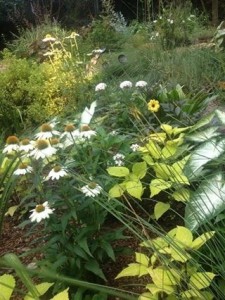 My ultimate hope is that many of you adopt the gambler attitude. It doesn’t have to be the high roller, high stakes approach, but try to roll with the plant punches, knowing they’ll come, and treat your gardening efforts as what they should be – a relaxing, and therapeutic addition to your daily schedule rather than a chore that’s only done on the weekends.
My ultimate hope is that many of you adopt the gambler attitude. It doesn’t have to be the high roller, high stakes approach, but try to roll with the plant punches, knowing they’ll come, and treat your gardening efforts as what they should be – a relaxing, and therapeutic addition to your daily schedule rather than a chore that’s only done on the weekends.
Posted by Kris Blevons

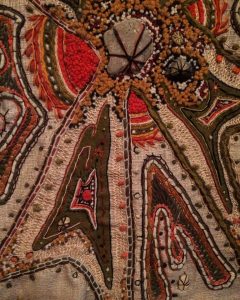 I grew up watching my mom create beautiful works of art using only a sewing needle and the colorful threads and yarns that she stitched into amazing designs on fabric.
I grew up watching my mom create beautiful works of art using only a sewing needle and the colorful threads and yarns that she stitched into amazing designs on fabric.
She showed her stitcheries in a few museum textile art exhibits, but mostly they were an artistic outlet for her and a joy for friends and family.
One hot, slow summer day Jamie mentioned it would be fun to make another Oak Street Garden Shop Mandala (designs using blooms, leaves, and other materials around the shop.).
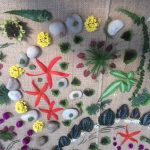 I agreed and mentioned the pieces of driftwood we’d gotten in reminded me of my mom’s stitcheries. She displayed them hung on pieces of driftwood found at area lakes where I grew up in Michigan and Wisconsin.
I agreed and mentioned the pieces of driftwood we’d gotten in reminded me of my mom’s stitcheries. She displayed them hung on pieces of driftwood found at area lakes where I grew up in Michigan and Wisconsin.
So we decided to try to make a mandala in the same manner as one of my mom’s stitcheries and started out by laying fabric onto a table and positioning a piece of driftwood at the top.
Jamie began gathering colorful blooms and leaves, and I laid out stones to create the lines and forms we could work from. I remember my mom saying it was the relationship of forms that she enjoyed most.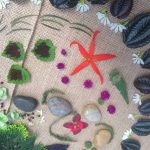
I did mention it was a hot summer day, right? Of course that’s why it was a slow day too, perfect for a project like this. However I have to say that it might have been even hotter than normal on this particular afternoon in the greenhouse.
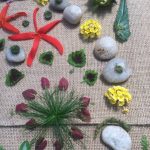 The table was set up up by the front door to take advantage of as much air as possible, but we had to eventually close one of the doors because it was too breezy and nothing would stay where we placed it.
The table was set up up by the front door to take advantage of as much air as possible, but we had to eventually close one of the doors because it was too breezy and nothing would stay where we placed it.
A few people came in looking for things here and there, and it was easy to tell the ones that didn’t really get it. “What is it?” was the usual question. “It’s a design”, we’d answer, “using leaves and things.” “Ahh…” they’d say uncertainly and slowly walk away.
But one woman and a group of young girls were intrigued and asked what various things were and why we were making it, exclaiming that it was beautiful.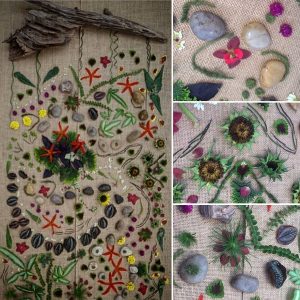
Here then are pictures of our “tapestry project” using my mom’s stitcheries as inspiration. And, whether you “get it” or not, we hope you enjoy the idea! If you like this one and would like to see some others we’ve made, look HERE. You can also click on Blog Posts, go to Archives and use the Search feature. Just type in mandala.
By Kris Blevons
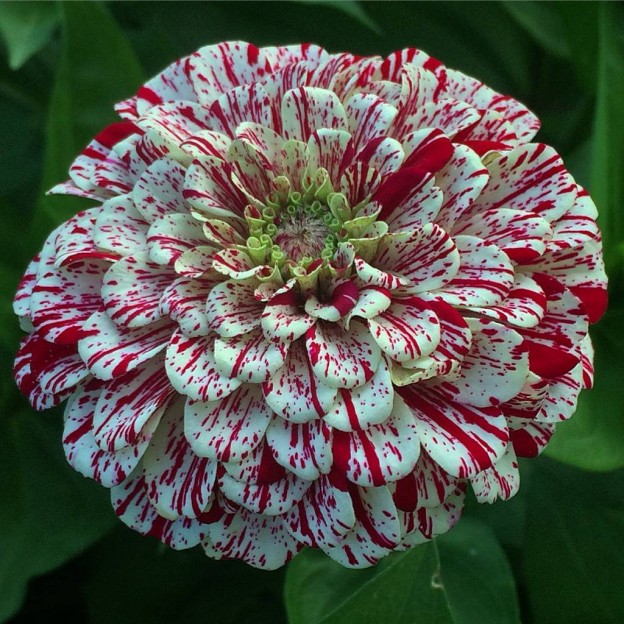
The pretty but very shy bright yellow goldfinches that have found the ‘Better Late Than Never’ Pollinator Garden across from the shop were still coming to the last of the bachelor buttons, larkspur, and some sunflowers that had seeded from last year’s plants when Bert and I began prepping the four beds for a new season mid-June.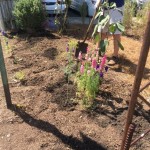
So, rather than pull every bachelor button and larkspur out to make way for new, I left what had been the prettiest colors of both, including a lovely lavender larkspur. Who knows, maybe some seeds of it will return in next year’s spring garden…
The beds needed some additional organic matter, and we added bag after bag of topsoil, soil conditioner, and PlantTone to each.
Bert and I took turns with my heavy pick axe, each strike of the tool working the amendments in without turning the soil, since that would only turn up buried weed seeds to the light where they’d happily germinate and grow. Then I took a garden fork and loosened it even more.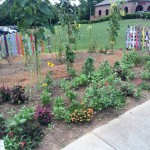
Any good garden begins with this all important work. Remember this in your own and always add more to your soil before replanting for the new season. We usually have bags of soil conditioner and topsoil in stock, and the PlantTone is a great organic amendment that adds nutrients too.
Finally the beds were ready for planting. After raking the beds smooth, it was time to sow the zinnia seeds in the two front beds. I also added lots of plants.
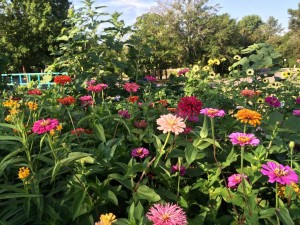 Tall cutting marigolds from a small grower north of Birmingham, tall purple and red gomphrena, a beautiful deep purple salvia and peach porterweed for the hummingbirds, angelonia, pentas, purslane, ornamental okra just for fun, pink mandevilla and malabar spinach vines on the two arbors, as well as seeds of moonvine and hyacinth bean to climb them too.
Tall cutting marigolds from a small grower north of Birmingham, tall purple and red gomphrena, a beautiful deep purple salvia and peach porterweed for the hummingbirds, angelonia, pentas, purslane, ornamental okra just for fun, pink mandevilla and malabar spinach vines on the two arbors, as well as seeds of moonvine and hyacinth bean to climb them too.
A few weeks later the last of the bachelor buttons and larkspur were pulled out, and the back two beds were planted with lots of sunflowers and tithonia, the orange flower the monarchs loved last year. I noticed that a yellow lantana and perennial butterflyweed had come back from last year also.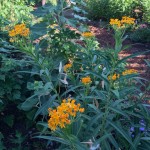
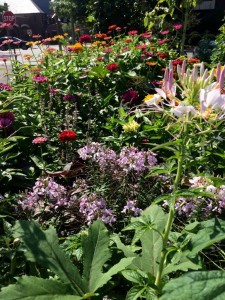 Of course the old fashioned Cleome, or spiderflower, had reseeded, but I also added another, shorter variety and a few more perennials this year, including coneflowers and caryopteris on each corner of the two back beds.
Of course the old fashioned Cleome, or spiderflower, had reseeded, but I also added another, shorter variety and a few more perennials this year, including coneflowers and caryopteris on each corner of the two back beds.
Just as plantings change and evolve with the years, so do structures in the garden. Pinkie painted the back fencing white this year, and we added a trellis piece painted a beautiful blue. I think we should try to grow sweet peas on it this fall, though I’ll have to tie string onto it for them to climb on.
The days have passed. It’s now August and the true heat has settled in; the zinnias love it and are in a riot of bloom: California Giants, Cactus, Peppermint Stripe, Northern Lights – beauties every one.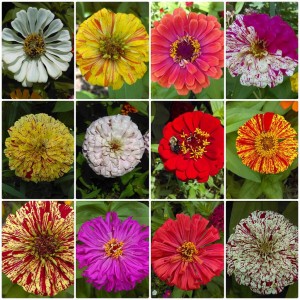
Watering, pulling stray weeds, and deadheading are the important chores on hot summer days, but sometimes I have to stop and simply watch. I see tiny skipper butterflies, bees, and even a garden spider weaving its web near the arbor and bench.
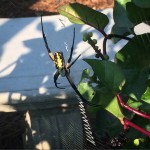 The sunflowers and tithonia will be blooming soon. They were planted a few weeks after the zinnias. I look forward to these towering bee and goldfinch magnets, in every color from pale yellow to deep red, and the brilliant orange flowers of the tithonia too. And, just the other day I threw out some seed of tall yellow cosmos, another butterfly flower.
The sunflowers and tithonia will be blooming soon. They were planted a few weeks after the zinnias. I look forward to these towering bee and goldfinch magnets, in every color from pale yellow to deep red, and the brilliant orange flowers of the tithonia too. And, just the other day I threw out some seed of tall yellow cosmos, another butterfly flower.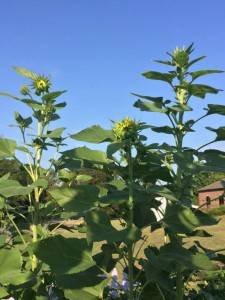
 The garden will reach its exuberant crescendo in the coming month before beginning a slow descent into fall. The zinnias will most certainly get mildewed leaves, and the heavy sunflower seed heads will droop on sturdy stems. But for now, it’s summer, and the garden is glorious.
The garden will reach its exuberant crescendo in the coming month before beginning a slow descent into fall. The zinnias will most certainly get mildewed leaves, and the heavy sunflower seed heads will droop on sturdy stems. But for now, it’s summer, and the garden is glorious.
By Kris Blevons

Last year about this time I wrote about the Million Pollinator Garden Challenge. I hope at least some of you are also participating, either formally or simply by planting some nectar rich flowers and providing for wildlife in your landscape.
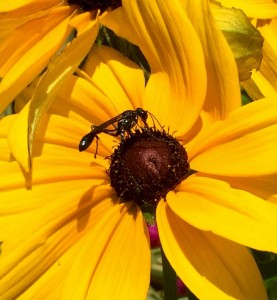 High summer here in Birmingham brings sizzling heat and lots of it, along with the welcome abundance of life in pollinator gardens. In mine the perennial summer phlox, coreopsis, coneflowers, butterfly weed, salvias, rudbeckias, and daylilys are abuzz.
High summer here in Birmingham brings sizzling heat and lots of it, along with the welcome abundance of life in pollinator gardens. In mine the perennial summer phlox, coreopsis, coneflowers, butterfly weed, salvias, rudbeckias, and daylilys are abuzz.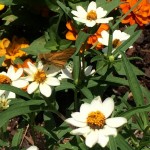
Annuals, especially those in the sun, are also capturing bee, butterfly and hummingbird attention, and I try to plant a variety for each in my sunniest beds. Angelonia, gomphrena, zinnias, batface cuphea, Mexican heather, purslane, and more jockey for space.
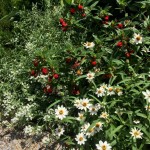 I take walks through my landscape early in the morning before leaving for work (And the heat builds.), deadheading, weeding, and simply admiring too.
I take walks through my landscape early in the morning before leaving for work (And the heat builds.), deadheading, weeding, and simply admiring too.
This is the tail end of daylily season, and on summer evenings I pull off unsightly yellow leaves, faded blooms that might be hanging on, and then cut spent scapes to the ground.
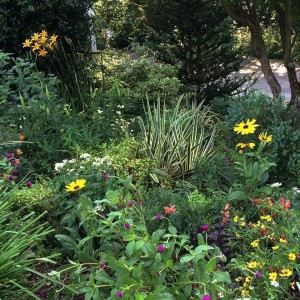 After they’re completely through blooming, if foliage looks rough, I’ll grab a handful, twist it, and cut it completely off. It will reflush with more sightly looking leaves lasting until the end of the season. Remember, you see foliage more of the year than flowers on most perennials. Plan for that when deciding where to plant them or if you’re dividing and/or moving them.
After they’re completely through blooming, if foliage looks rough, I’ll grab a handful, twist it, and cut it completely off. It will reflush with more sightly looking leaves lasting until the end of the season. Remember, you see foliage more of the year than flowers on most perennials. Plan for that when deciding where to plant them or if you’re dividing and/or moving them.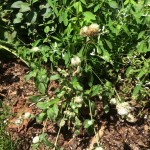
If it’s been very dry, the early morning hours are spent watering any plants that look wilted. If they’re left without water too often, the stress will weaken them and they’ll be more susceptible to disease and insect attacks.
I’ve noticed some of the small white gomphrena that I planted quite late are struggling. I don’t think they’re getting enough sun, and they’ve gotten parched more than a few times. I’ll be keeping an eye on them.
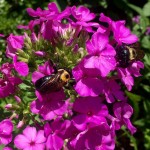 The summer phlox and coreopsis are in full bloom and the bees love them. I watch tiny skipper butterflys light on the coreopsis; they move so fast! When these two play out I’ll cut the faded flowers off the phlox and wait for a second, smaller display.
The summer phlox and coreopsis are in full bloom and the bees love them. I watch tiny skipper butterflys light on the coreopsis; they move so fast! When these two play out I’ll cut the faded flowers off the phlox and wait for a second, smaller display.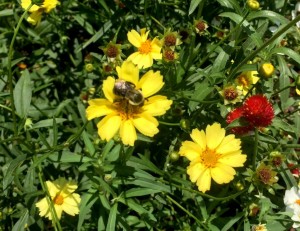
The coreopsis will be sheared back since there are too many small flowers and not enough hours in the day to deadhead each one.
As with most summer blooming perennials, I’ll cut stems back completely to neaten the garden and give late blooming plants room to shine when the weather finally cools.
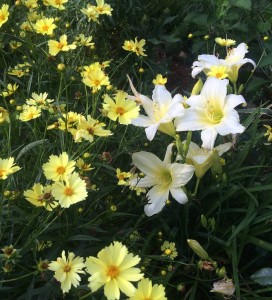 Honestly, though, it’s really too hot to do much more than water, deadhead, and pull opportunistic weeds that seem to come out of nowhere. Even as I water I’m dreaming of my vacation north to see family and friends. I know my garden will be here when I return, grown even more lush with high summer’s heat and, hopefully enough rain too.
Honestly, though, it’s really too hot to do much more than water, deadhead, and pull opportunistic weeds that seem to come out of nowhere. Even as I water I’m dreaming of my vacation north to see family and friends. I know my garden will be here when I return, grown even more lush with high summer’s heat and, hopefully enough rain too.
By Kris Blevons
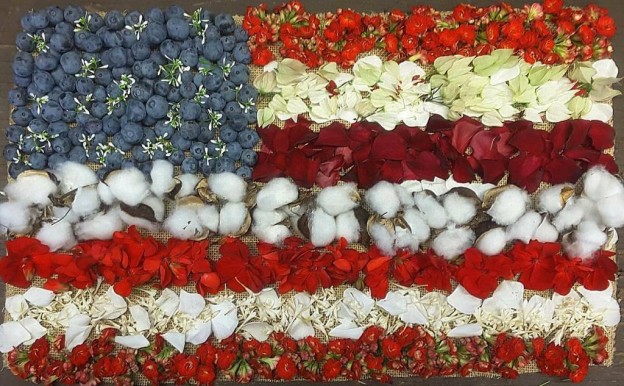
Last year’s massive “Botanical Fireworks” Fourth of July project was pretty hard to top. This year we went a little smaller, and had some fun creating this tabletop botanical “flag”. So far it’s made its way onto Facebook and Instagram, and after this post publishes I’ll put it on Pinterest too. How did we manage years ago without all this social media? They were simpler times, that’s for sure.
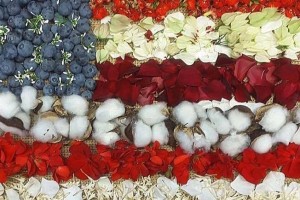 Ingredients for our flag project included blooms cut from the bleeding heart vine (Clerodendron) growing around our entrance, kalanchoe, vinca, dipladenia, euphorbia, and geranium petals, cotton bolls and blueberries (We couldn’t resist eating some!)
Ingredients for our flag project included blooms cut from the bleeding heart vine (Clerodendron) growing around our entrance, kalanchoe, vinca, dipladenia, euphorbia, and geranium petals, cotton bolls and blueberries (We couldn’t resist eating some!)
Happy Fourth of July!!
By Kris Blevons
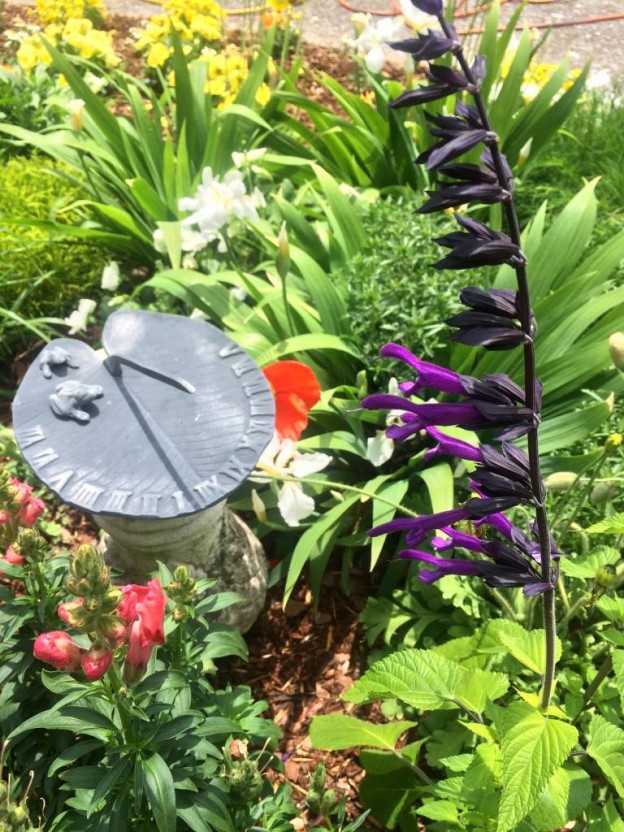
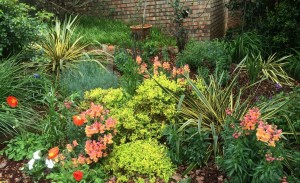 A southern garden, not unlike like gardens elsewhere, is in constant change one day to the next, a living work of art subtly shifting in quiet or awe-inspiring ways. But here in Birmingham, Alabama, we’re also able to revel in every season…each spring, summer, fall, and even winter, since, for better or worse, there’s no real down time, no blanket of snow to envelope the garden in silence. Each season slides easily into the next, with the appropriate and perfect accompaniment of plants.
A southern garden, not unlike like gardens elsewhere, is in constant change one day to the next, a living work of art subtly shifting in quiet or awe-inspiring ways. But here in Birmingham, Alabama, we’re also able to revel in every season…each spring, summer, fall, and even winter, since, for better or worse, there’s no real down time, no blanket of snow to envelope the garden in silence. Each season slides easily into the next, with the appropriate and perfect accompaniment of plants.
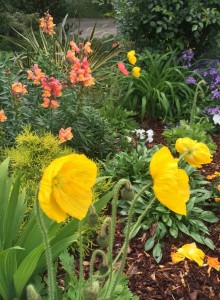 The mental transition from spring to summer is the hardest for me though. I want the perfect spring days to go on and on and wish the peonies, poppies, pansies, bachelor buttons, Japanese roof iris, and foxglove could bloom forever. But I know the relentless heat will soon arrive to stay for good and the earliest of the garden bloomers will go as the temperatures and the humidity rise.
The mental transition from spring to summer is the hardest for me though. I want the perfect spring days to go on and on and wish the peonies, poppies, pansies, bachelor buttons, Japanese roof iris, and foxglove could bloom forever. But I know the relentless heat will soon arrive to stay for good and the earliest of the garden bloomers will go as the temperatures and the humidity rise.
So, I’m mindful each day to appreciate the spires of foxglove and blooms of colorful snapdragons I planted on cool fall days last October and that are blooming now, even as I tuck in my usual summer annuals of zinnias, lantana, gomphrena, and more in my hot, sunny front bed. As I plant I pull out many spent pansies and tired poppies, choosing to leave those that are still adding color.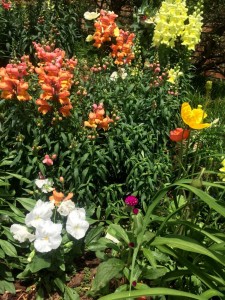
Many customers I see each day have completely pulled out their scraggly pansies and are ready to move on. They walk out of Oak Street Garden Shop loaded up with top soil or soil conditioner to loosen the soil, PlantTone to feed it, and lots and lots of plants. They gather perennials that will come back each year, annuals for lots of continuous color, and herbs and vegetables to harvest through the summer.
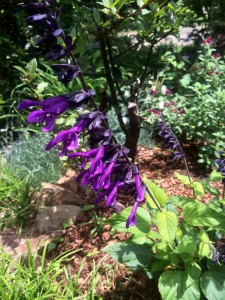 This year I’ve decided to add a new tall salvia selection called ‘Amistad’. I’ve fallen in love with its beautiful rich purple blooms and think it will be the perfect compliment for the yellow day lilies and other hot colors I usually use in this spot.
This year I’ve decided to add a new tall salvia selection called ‘Amistad’. I’ve fallen in love with its beautiful rich purple blooms and think it will be the perfect compliment for the yellow day lilies and other hot colors I usually use in this spot.
African blue basil is another addition this year that I’m planting for the honeybees. On an arbor I’ve decided to put a Malabar spinach plant, a fast growing and beautiful vine whose tender new leaves are edible. Trying new plants, and even different selections of those I’ve used before, makes each season a little different and a lot of fun.
It was a hot day today. I survey the garden as I water my new plantings in, eying a spot previously occupied by yellow violas. Yes, some bat face cuphea would look just right there, and I think the hummingbirds would like it too.
By Kris Blevons
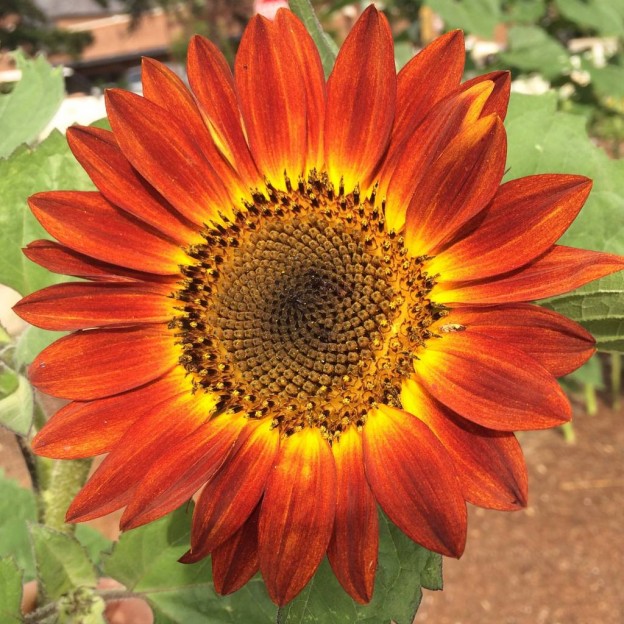

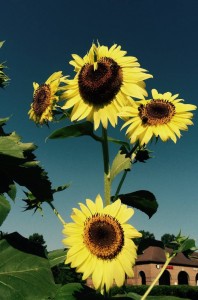 The great thing about sunflowers, if you’ve ever planted them by seed, is that often they’ll reseed, or come back the next year, in the same spots or somewhere nearby. This is more likely to happen if you’re not diligent about deadheading (keeping the spent blooms cut off).
The great thing about sunflowers, if you’ve ever planted them by seed, is that often they’ll reseed, or come back the next year, in the same spots or somewhere nearby. This is more likely to happen if you’re not diligent about deadheading (keeping the spent blooms cut off).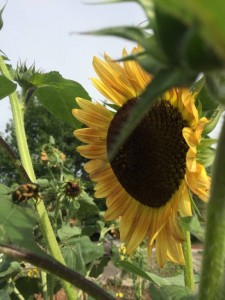
Late last fall the sunflower plants of summer were cut down and muscled out of the ground. By that point they had enormous stems and were very well rooted. It took some time to clear the garden of debris.
Obviously, not all of the sunflower seeds were composted – and I’m glad they weren’t – because this year, in addition to the extra sunflowers I seeded in late June, I already had these beauties up and blooming.
What a great way to extend the flower season in our ‘Better Late Than Never Garden’! Those shown here have bloomed out at this point, but their flower seed heads have created a feast for flocks of goldfinches…such a pretty sight early in the morning!
Sunflowers are so easy to grow from seed, and we carry many varieties from our supplier, Botanical Interests. New packets are available each spring, and the best selection always goes to the early birds!
Buy your seed and wait to sow them until the soil is really warm. You can begin sowing them directly in the ground any time after the middle of May and sow more every couple of weeks for even more continuous bloom.
And, if you get a late start, don’t worry! Remember, this garden gets seeded as late as the end of June and provides continuous color through September. So much happiness from a few packets of seed!
By Kris Blevons
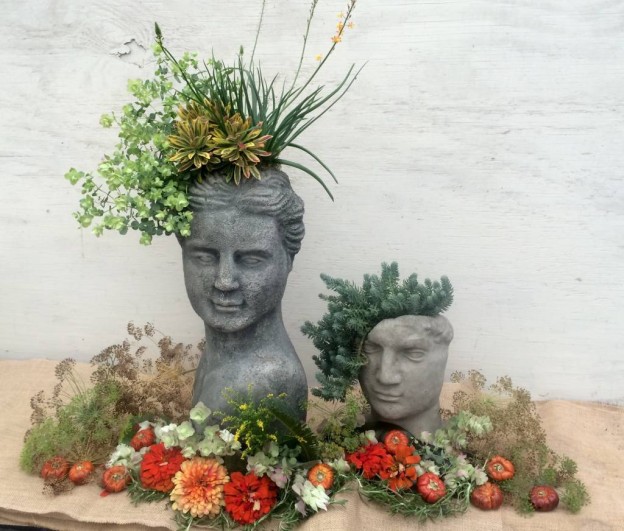

Pinkie’s planting in a cast stone head planter…
I’ve seen some interesting head planters on Pinterest and other social media sites over the past few years, and decided this spring it was time to get in on the fun. Since these pieces are heavy cast stone, they’re not going to tip over in winds and consequently won’t break easily either. The planting space isn’t terribly roomy though, so extra care needs to be taken to ensure they don’t dry out.
Pinkie planted the one shown in the first pictures here using mostly succulents. They’re the perfect choice for planting in small spaces like this since they tolerate dry soil. Though the aeonium at the front is a short-term cool season plant, you can see in the second picture that the peach purslane and yellow bulbine were happy to take over the show once the aeonium pooped out in the heat.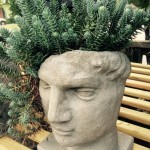
A sedum ‘Blue Spruce’ is the single plant in the second, smaller head planter. It was planted at the end of June, and this picture was taken the beginning of September. Not bad for a tiny planting space!
We had one head planter left at the end of August, and it looked too empty. Since Pinkie had planted the other two for sun, I decided to try one with something in it for shade or filtered sun. While Pinkie’s head planters really look like hats, I decide mine would be a bit more bohemian.
One of my favorite plants is Hemigraphis ‘Red Flame’ or waffle plant. In container plantings it will steal the show, spilling out in a silvery purple wave. To it I added a tiny piece of a blue carex, a sedge that works very well in dry shade. The final addition was a dried pod for a “hat pin”. Now to find just the right spot…
By Kris Blevons
 The troughs in front of Dyron’s Restaurant took a real hit this winter, so I was more than happy to pull out all that had died and replant for the summer.
The troughs in front of Dyron’s Restaurant took a real hit this winter, so I was more than happy to pull out all that had died and replant for the summer.
Last year’s planting included a pretty yellow thryallis, but this year I opted to leave it out. I did repeat the ‘Red Flash’ caladiums that had done so well last year and left the Carex ‘Evergold’ and Golden Acorus in each trough as well since they had sailed through the winter cold. Keeping some perennials in planters as large as these makes sense.
This year, instead of zinnias, I opted for vinca and lantana for some white and yellow blooms respectively. They should definitely take the hot blazing afternoon sun. A dark leaf potato vine will trail over the edge, and its color should contrast nicely with these containers.
Last summer the Red Flash caladium almost overwhelmed the thryallis, so this year I decided to give them a run for their money and added a chartreuse coleus called ‘Wasabi’ that will get just as enormous. Here’s to another growing season!
Maintenance of this planting will involve consistent watering and the occasional clip back of the lantana and coleus. Seed pods that form on the caladiums will also be cut and any yellow leaves removed.
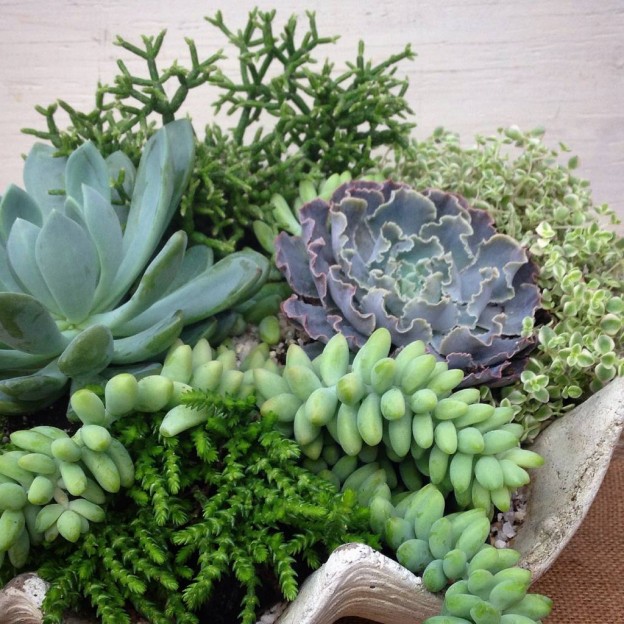
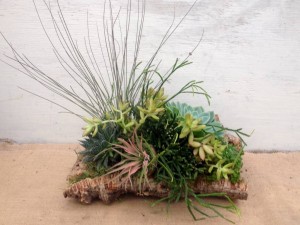
Succulents can be quite colorful…
Have you found a spot this year to try a few succulents? These tough plants will make any sunny spot more interesting, come in all shapes and sizes, and can be combined with air plants and others that don’t mind dry feet.
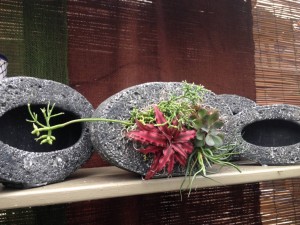
These oval containers offer interesting planting possibilities…
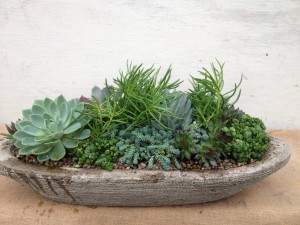
A succulent planting in a customer’s stone trough…
Think about using them with purslane, portulaca, creeping thyme, Mexican heather, bulbine, yuccas, or anything else that likes it hot and dry.
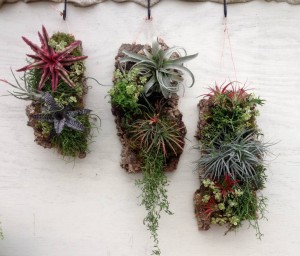
Molly’s cork pieces will hang on porch columns…
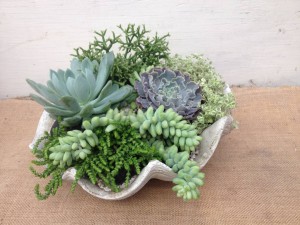
Going into the warmer months many succulents can be used. Some are winter hardy, and those we’ll always have outside in the nursery. Tender succulents that you’ll need to bring inside when fall arrives can be found in the greenhouse.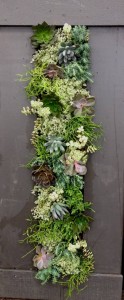
If you have a dry, sunny spot in your landscape, try a few of the hardy sedums. If the drainage is good, they’ll be happy and will spread, though the test of their hardiness will be in the winter.
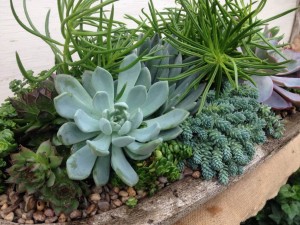 Hen and chicks (Sempervivum species) is extremely cold hardy and will breeze through the winter if they’re not waterlogged. Soggy, cold soil is definitely not to their liking!
Hen and chicks (Sempervivum species) is extremely cold hardy and will breeze through the winter if they’re not waterlogged. Soggy, cold soil is definitely not to their liking!
Keep in mind that a single pot filled with one type of succulent can be as beautiful as many in combination and, with the right container, can be quite dramatic. So there’s no need to feel intimidated; just dive in, pick a plant you like, and have fun!
Posted by Kris Blevons
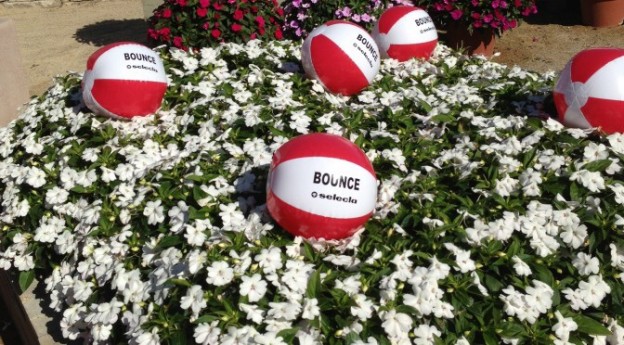

Bounce impatiens -photo courtesy Ball Hort
We knew plant breeders would be working double overtime to come up with an alternative to bedding plant impatiens that have been subject to downy mildew disease the past few years and are so happy to hear of a new impatiens series called Bounce. We’ll be offering these new plants this spring and will be trying them in our own gardens. This is the description from our local grower’s website:

Bounce impatiens – photo courtesy Ball Hort
“Introduced for 2015, the Bounce series of Impatiens is bred to resist Downy Mildew, have the bloom count of the classic walleriana-type impatiens (Super Elfins, Dazzlers, etc..) and perform in both shade and sun! Possibly best with some afternoon shade here in the Birmingham area. The series is named for its ability to bounce back from a wilt without dropping its blooms.”

Bounce impatiens – photo courtesy Ball Hort
This is such good news! A recent conversation with this local wholesale grower revealed that, while the color range isn’t extensive (yet), it does offer white and varying shades of pink as well as a lavender. They can easily be planted 15″ apart in a garden bed and will fill in beautifully as shown in the picture above.

Bounce impatiens – photo courtesy Ball Hort
In addition to the Bounce series of impatiens, Sunpatiens are also a good choice for disease resistance.
You will still see the downy mildew prone Dazzler, Super Elfin and other impatiens for sale around town. We will order them for you, at your request, but will sell them with the warning that they are susceptible to downy mildew disease.
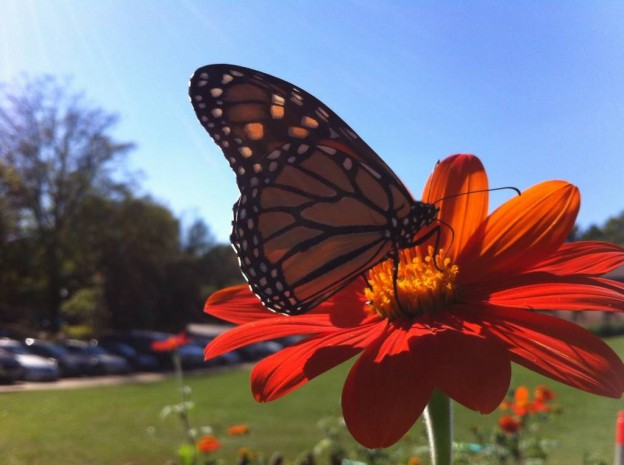
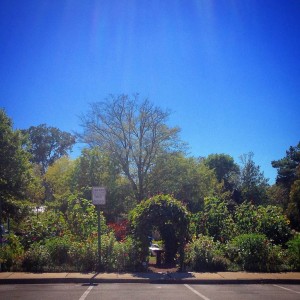
View From the street…Hyacinth Bean Vine on the Arbor
So many folks have stopped me, asking for a plant list of flowers in the “Better Late Than Never” garden, that I decided it was high time I posted this for those of you who’d like to have something similar next year. Obviously our garden is sited in full, daylong sun, so plants were chosen with this in mind. You’ll need to provide at least 4-6 hours of sun, with regular watering and deadheading, to maintain your flower garden next year too.
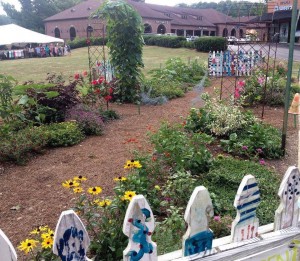
Rudbeckia ‘Indian Summer’ foreground. On arbor, moonvine and red mandevilla…
Any good garden begins with good soil, and, with previous vegetable garden plantings, ours had been amended with soil conditioner, compost and added topsoil. This past season we also added bags of PlantTone as well, raking it in lightly. No tilling was done since that tends to turn up weed seeds, and, once they hit the light, they all sprout, turning the garden into a weedy mess!
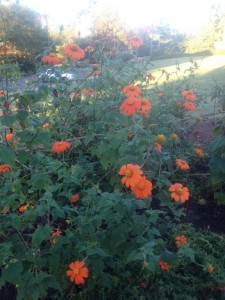
The tithonia came on strong, late summer…
In a previous post I mentioned how late the garden was planted (not until the end of June!), so it was incredibly hot when the sunflowers and zinnias were planted by seed. This is actually very good, since they need very warm soil to germinate and grow happily and consistent watering as well. I know many of you thought we were a little crazy to be planting in the incredible summer heat, though. (This is a good time to remind all of you to wear a hat if you’re out in the heat and sun and be sure to provide water for yourself too!) Here’s a post highlighting how much the garden had grown by late summer. So many of you talk about how it seemed to explode overnight. Actually, it was steadily growing each day!
Here, then, is the plant list for a flower garden to attract bees, butterflies and hummingbirds in Birmingham, Alabama, and surrounding areas with tips on planting and maintenance:
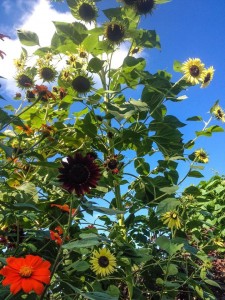
The sunflowers, planted from seed, towered over the garden…
Sunflowers – We raided our Botanical Interests seed rack and planted a mix of sunflowers from Lemon Queen, mixed packs, and solid reds and yellows directly into the ground, then waited, impatiently, checking them every day – and watering each day – until they sprouted. Watching them grow and seeing folks taking pictures made all the effort worthwhile for these towering beauties.
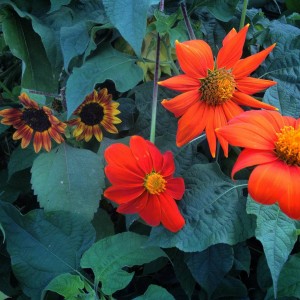
Tithonia…
Tithonia, Mexican Sunflower ‘Torch’ – These also were planted from seed at the same time as the sunflowers. At first the sunflowers eclipsed them, but, by the very end of summer after the sunflowers had played out, the Tithonia took over, and everyone was asking about it. It boasts never-ending orange flowers that attract yellow sulphur, skipper, painted lady, and, finally, at the end of the season, monarch butterflies. A must for any sunny flower garden. I kept it deadheaded and staked but left some to lean and sprawl since the stems got quite large.
Tall cutting zinnias – The zinnias were also planted at the same time as the sunflowers and Tithonia. Again, we used Botanical Interests seed leftovers on the seed rack – all mixes of tall varieties. We also had a few green ‘Envy’ zinnia plants in cell packs left over from spring. These I cut back by half and planted in the front two beds while we waited for the zinnia seeds to come up. As seedlings came up I pinched them back to promote branching, and they were kept deadheaded to promote more blooms so everyone could enjoy the flower display.
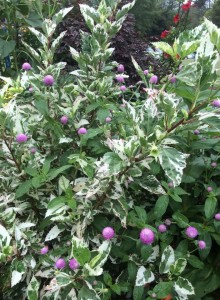
Variegated hibiscus with the tall pink gomphrena growing through it…
Hibiscus – There were two hibiscus varieties planted in the garden. Unlike fancy big-blooming hibiscus you may be more familiar with, these were planted for their foliage appeal, with blooms being secondary. The first is an ornamental red leaf hibiscus, and one of these was planted on each side of the back arbor. By the middle of October, they had each grown to enormous proportions, adding another depth of color to the garden, growing up through the tithonia and moonvine.
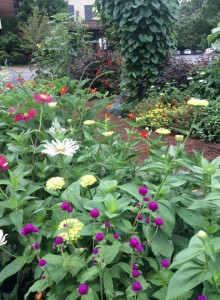
Zinnias and gomphrena…moonvine and red leaf hibiscus…
I kept them clipped periodically to keep them in check and in proportion to the rest of the surrounding plants. The second was a variegated ornamental hibiscus. One of these was planted on each side of the front arbor and had pink gomphrena and tall cutting zinnias growing through it. They were not as vigorous as the red leaf but still added another leaf variation in the garden.
Gomphrena – A plant I wouldn’t be without in the flower garden. It never looks like much in a pot, but in the garden its globe-like flowers add a completely different silhouette among all the daisy-like blooms. And it is tough! We planted transplants of tall purple, red, and pink gomphrena and also added a short variety in all four beds. Here’s another post that features gomphrena.
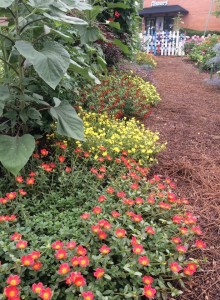
Purslane, red bat face Cuphea and purple gomphrena edge the beds…
Purslane – This low-growing, succulent-like annual is an amazing bee magnet. We had literally hundreds of honeybees each morning on the bright yellow, orange, and red blooming plants. They are best planted along the edge of hot, sunny beds. The flowers close late in the day, but that’s hardly noticeable if you provide other flowers to look at! Be sure to take a look at the video of the honeybees on our YouTube page.
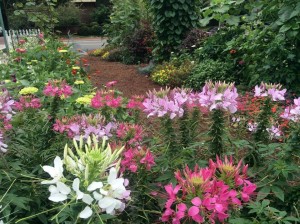
Cleome – Spider Flower…
Cleome (Spider Flower) – We had a flat of scraggly looking cleome left over from spring that needed a home…and what a home it got! I cut them back by half so they would branch and be fuller, and were they ever! Don’t hesitate to cut back stems of these flowers through the summer. When you see numerous seed pods hanging down the length of the bloom, it’s time to cut them back. Don’t worry; they’ll continue to bloom and will probably reseed next year for you. Old fashioned flowers, they attract butterflies and bees too.
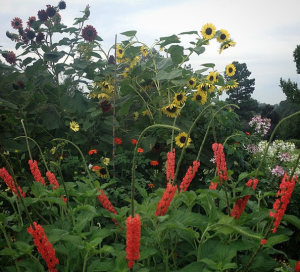
Porterweed and Sunflowers…
Porterweed – An interesting plant that sends out long bloom spikes with blossoms the hummingbirds and sulphur butterflies adore. I would plant it again for that reason alone! I was also impressed that it never seemed to be bothered by insect pests.
Cuphea llavea, Red bat face cuphea – You may not have noticed this plant right away, but the hummingbirds sure did! Planted along the front of the sunflowers and under the tithonia, it added a shot of red along the ground. Extremely tough and virtually carefree, it flourished with less than optimal sun, as it eventually was shaded out by the towering sunflowers. Even so, it was one of the last things removed at the end of October.
Cuphea ignea, cigar plant – Another planted for the hummingbirds. This one sports orangey tubular flowers on a rangy plant that I put right in the middle of the zinnias. This post tells you more about this unusual plant.
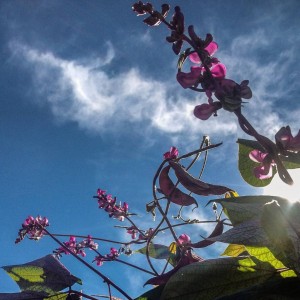
Hyacinth bean vine, sillouhetted against a blue sky…
Hyacinth Bean Vine – We started the hyacinth bean vine from seed, planting them all along one side of the front arbor, then waited and waited for it to come up. It finally did, but the leaves were being chewed to pieces and it didn’t look happy at all. Since the garden is pesticide free, the offending leaves were removed and it was given liberal doses of Annie Haven’s Authentic Brand Manure Tea. Gradually it grew stronger, whatever was chewing it moved on, and buds began to form. By September everyone was asking what the beautiful purple flowering vine was.
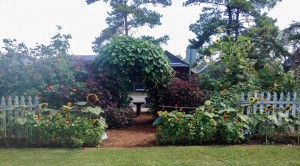
The back side – Moonvine on the arbor with the red leaf hibiscus on either side…
Moon Vine – The moonvine was planted on the back arbor and was the last one we had in stock from spring (They’re easily grown from seed too.). For the longest time, it seemed to be all leaves until buds began to form late in the summer. Just about the time it threatened to engulf the arbor and everything around it, the fragrant nighttime blooms began to open each evening and were still open each morning.
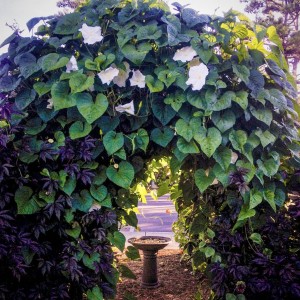
Late summer – the moonvine and red leaf hibiscus have grown together…
Mandevilla Vine – A red mandevilla was planted on one arbor on the other side of the moonvine, and a pink mandevilla was planted on the arbor on the other side of the hyacinth bean vine. The pink mandevilla was still growing strong at the end of October. The red mandevilla was swallowed up by the moonvine! Both are heat-loving vines and quite beautiful and carefree.
Cuphea hyssopifolia, Mexican heather – Yes, yet another Cuphea and one for the bees. This one is a mounding annual that’s just right for filling in spots toward the front of a flower bed. Bees love it, and it’s virtually maintenance free.
Otomeria – A plant I’ve never grown before this summer but that was very impressive in the garden! There were only two, and you may not have noticed them. They love our heat and hopefully will be available for you to try next summer. The two in the garden were planted in August and bloomed until the end of October, when they were finally pulled out. They offered clean white blooms on sturdy mounding plants.
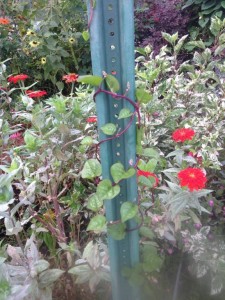
Malabar spinach vine
Malabar Spinach – Not spinach at all, but an edible and heat loving vine with pretty purple flowers. Like the otomeria, this was another fun plant to try that was also new to me. It did extremely well, planted late, growing up each arbor and up the very ugly 2 hour parking sign. If you’d like to learn more about this fascinating plant, click HERE.
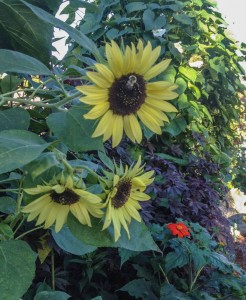
One of the many sunflowers in the garden…
Rudbeckia ‘Indian Summer‘ – A sturdy annual Black-eyed Susan with large blooms, I’m going to leave these in the ground in hope that they’ll come back next year. We shall see!
Lantana – A couple of lantana were placed at the back of the sunflowers where they’d get the most sun. They were planted quite late (August) so didn’t have much time to develop. I’m going to leave them in those spots to see if they’ll return next year. They might if the winter is mild enough.
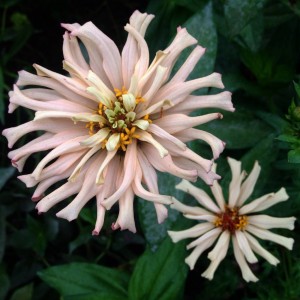
Cactus zinnia…
And the rest….
Assorted tip cuttings of succulents were placed at the front corner by the sign and began to really take hold by the end of the summer. A rosemary plant was left in from the previous garden and a perennial Cardoon was placed on the end of one bed for its spiny, silvery foliage. A few dwarf purple ruellia, Mexican petunia, were added by the back rose arbor. Finally, a couple of shade-loving torenia were planted under the sunflowers (They were just right to see from a child’s perspective!).

Dwarfed by the sunflowers…
So, there’s your plant list if you’d like to have a similar summer garden next year. Please don’t feel tied to just these plants, though. So much of the joy of gardening involves trying new things and discovering how they work in your landscape. Meanwhile, for now, our winter garden is being planted gradually and offers an entirely different set of possibilities, again some from seed, others from transplants. I hope you enjoy the view!
By Kris Blevons
Our “Better Late Than Never” flower garden, planted in late June, is proving that any time is the right time to plant a garden! The response from the community has been quite gratifying as well.
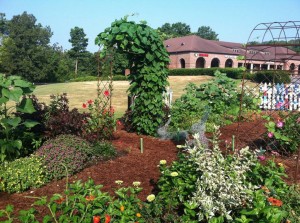
Photo courtesy Dean Veren
A couple of examples: A gentleman walking by, headphones on, crosses the street away from the garden, then pauses. Taking off his headphones and turning around, he walks back across the street just to tell me what pleasure the garden gives him each morning on his daily walk. Another woman stops to say she and her sister walk by once a week and really enjoy watching the changes as flowers bud and then bloom. My favorite might well be the little girl calling out from a car driving by, “Your garden is really pretty!”
For all of us who plant a garden, it’s also exciting to see how quickly plants grow. One morning the sunflowers are just beginning to come up on wobbly, thin stems, and then, almost overnight it seems, they’re over 5′ tall and reaching for the sun. Zinnias, those stalwarts of any sunny, summer garden, have been the stars so far, and we keep planting more. The tall purple and pink gomphrena, cigar plant, peach porter weed, gloriosa daisies, tithonia, milkweed, cleome, and, of course, the sunflowers aren’t far behind in star power though. A garden changes daily, and this one is no exception!

Pink and white spider flowers, (cleome) in full bloom…
The honeybees have found it too. Each morning the large, colorful patches of the low-growing, succulent purslane are host to hundreds of them. There’s no need to be frightened; they’re just going about their business, pollinating and returning to their hives each day. The sunflowers are beginning to show off now. And, like gluttons needing more food, we’ve planted another group of them around the very perimeter of the garden. This way, we reason, when the first of them have finally played themselves out, there will be more to look forward to.
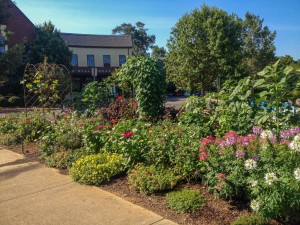
The bees, butterflies and hummingbirds appreciate the flower garden…
Yes, that is why we garden; isn’t it? Planting, tending, and watering aren’t chores when the end result is so gratifying, and we know the next day will bring something new in bloom. Sure, not everything works out. Some of the zinnias didn’t make it, the moonvine seems to be all leaves, the hyacinth bean vine is chewed to bits; but we filled in where the zinnias pooped out, the moonvine leaves are a beautiful green, and, after a few doses of Haven Brand Natural Moo Poo Tea, the hyacinth bean vine is coming along.
A parting thought…Anyone can plant a garden. It can be as small as a few pots of marigolds this fall or as big as you want it to be. There will be great successes and, yes, some failures too; but that’s true of anything in life. Cliché as it sounds, the greatest pleasure is the joy it brings others…and that is priceless.
By Kris Blevons

A hummingbird’s dream…cigar plant and salvia
Cuphea ignea, the cigar or firecracker plant, originates in Mexico, where it becomes a 2′-3′ tall shrub in warm, sunny spots. In my garden, it dies to the ground each year, reliably appearing late in the spring as temperatures become increasingly warmer. We are probably close to its farthest northern hardiness, so I mulch it well each fall. Even so, I thought for sure it and my other cuphea, C. micropetala, would be goners after this past ridiculously cold winter. But, surprisingly (At least to me!), they are back as happy as ever. And that makes me happy too!
The best part of having these in the sunny garden, though, is the abundance of hummingbirds and butterflies they attract. The sunniest, most protected areas in my garden happen to be practically right outside the front door. What an advantageous site to watch the hummers dart back and forth from salvia to cuphea and back again.
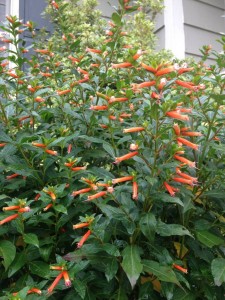
Cuphea ignea
The Latin word ignea means fire, and the tubular flowers do resemble (sort of) the ends of a lit cigar. But it’s the tubular shape of the flowers and the orangey-red color that attracts all the hummingbirds. Cuphea ignea (and micropetala) are fast growers once heat sets in for the duration of summer. This year I didn’t pinch them back at all to control their height. Since they’d managed to make it through this particularly hard winter, I thought they deserved to be left to grow without any interference; and they’re blooming earlier than normal because of it.
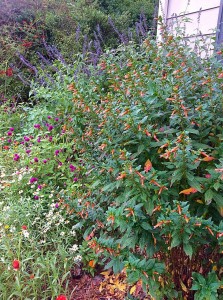 I will cut it back some if it gets too “leggy” looking in my front bed. You can alleviate this problem by placing it behind mid-height annuals like angelonia, some salvias, gomphrena, or even foliage plants like sun caladiums or coleus. So, get out in your garden and scout out a place that’s sunny, protected and within easy sight lines and try at least one cuphea so you can watch the hummers zinging by too. You won’t be sorry!
I will cut it back some if it gets too “leggy” looking in my front bed. You can alleviate this problem by placing it behind mid-height annuals like angelonia, some salvias, gomphrena, or even foliage plants like sun caladiums or coleus. So, get out in your garden and scout out a place that’s sunny, protected and within easy sight lines and try at least one cuphea so you can watch the hummers zinging by too. You won’t be sorry!
If you want a cigar plant for your garden and hummingbirds, we’ll carry it as long as it’s available this summer from our local grower.
By Kris Blevons
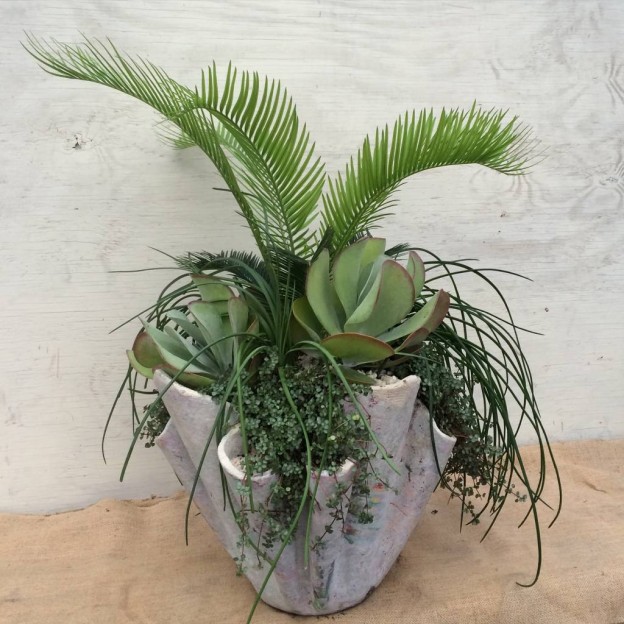
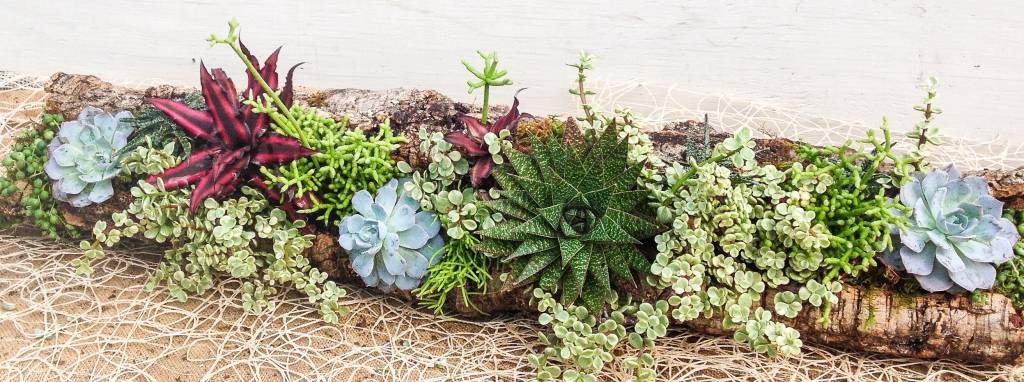 While parts of the country are enjoying an unusually cool summer, here in the heart of the south the temperature and humidity can still soar. Unfortunately, even nighttime temperatures rarely provide respite from the unending heat, though, thankfully, we (and our plants!) have had a couple of welcome breaks this year.
While parts of the country are enjoying an unusually cool summer, here in the heart of the south the temperature and humidity can still soar. Unfortunately, even nighttime temperatures rarely provide respite from the unending heat, though, thankfully, we (and our plants!) have had a couple of welcome breaks this year.
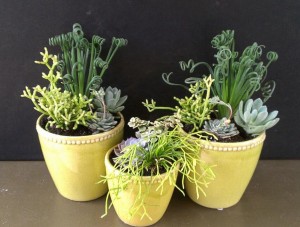 While there are plenty of tough, heat tolerant plants that, with the proper maintenance, work very well in our landscapes, this post is going to concentrate on succulents, with examples of some recent container plantings. Look HERE for more succulent arrangements we’ve done in the past too.
While there are plenty of tough, heat tolerant plants that, with the proper maintenance, work very well in our landscapes, this post is going to concentrate on succulents, with examples of some recent container plantings. Look HERE for more succulent arrangements we’ve done in the past too.
Three bright yellow pots provide a temporary home as a centerpiece trio, then these plants will move outside for the rest of the season. The curly little number here is an interesting, and new to the plant scene (at least for us), succulent-like plant (It’s actually a bulb.) called Albuca spiralis ‘Frizzle Sizzle’. Native to South Africa, its growth actually slows during the heat of summer, and it must be kept on the dry side during this resting period. As we move into the colder winter months, it will begin to grow again and should make a relatively easy indoor plant for a bright room inside.
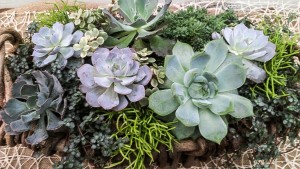 The basket planting shows a tiny leaf blue-green succulent-like plant that is actually a Pilea called ‘Aquamarine’. It has fast become a favorite for succulent and other arrangements in containers. The tiny leaves grow quite quickly, mingling with other plants and eventually trailing, seemingly indefinitely! This mixture also has echevarias, workhorse succulents that can grow to enormous proportions.
The basket planting shows a tiny leaf blue-green succulent-like plant that is actually a Pilea called ‘Aquamarine’. It has fast become a favorite for succulent and other arrangements in containers. The tiny leaves grow quite quickly, mingling with other plants and eventually trailing, seemingly indefinitely! This mixture also has echevarias, workhorse succulents that can grow to enormous proportions.
The square brown planter is home to a variety of succulents, including a number of Hechtia glomerata. It’s in the Bromeliad family and native from Texas down into Central America. Species of Hechtia are terrestrial and inhabit dry, rocky places and often seen growing on vertical walls along rivers, where the soil drains exceptionally well. Hechtia is a plant that’s new to us this year. We’ve noticed it has the spiny edges on leaves that some bromeliads are known for.
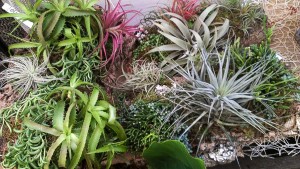 Succulent plants and air plants, Tillandsia, are perfect partners, as you can see in this cork bark composition. Here’s the Hechtia again, with another plant called Rhypsalis. Rhypsalis is another fascinating plant. It’s actually in the cactus family and most are native to Brazil. Its name is derived from the Greek word rhips, which means wickerwork and refers to the slender, flexible, reed-like stems.
Succulent plants and air plants, Tillandsia, are perfect partners, as you can see in this cork bark composition. Here’s the Hechtia again, with another plant called Rhypsalis. Rhypsalis is another fascinating plant. It’s actually in the cactus family and most are native to Brazil. Its name is derived from the Greek word rhips, which means wickerwork and refers to the slender, flexible, reed-like stems.
Rhipsalis are primarily epiphytic, meaning they live in trees, but some also grow in the cracks of rocks. Quite a versatile little cactus! It doesn’t have spines like a conventional cactus; instead the stems seem almost flattened and branch frequently. Flowers are among the smallest of cactus flowers and usually white, though some may be tinged with yellow or red.
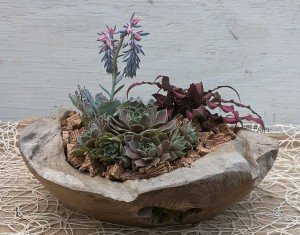 The wooden bowl shows an old favorite, sempervivum or hen and chicks, a well known succulent and widely available in many rosette colors. One thing we’ve learned about “semps” is they really do appreciate a bit of shade in the afternoon here in Birmingham. Maybe it’s our constant humidity. At any rate, a touch of shade seems to help.
The wooden bowl shows an old favorite, sempervivum or hen and chicks, a well known succulent and widely available in many rosette colors. One thing we’ve learned about “semps” is they really do appreciate a bit of shade in the afternoon here in Birmingham. Maybe it’s our constant humidity. At any rate, a touch of shade seems to help.
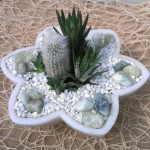 Another cactus called ‘Old Man’ and a little succulent called Haworthia are at home in a small marble container. There are no drainage holes in this piece, so careful watering must be done sparingly.
Another cactus called ‘Old Man’ and a little succulent called Haworthia are at home in a small marble container. There are no drainage holes in this piece, so careful watering must be done sparingly.
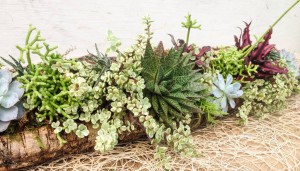 Finally, a long, very narrow piece of cork bark is home to a varied selection of succulents including Portulacaria afra, sometimes called miniature variegated jade plant though it’s a different species. Its small, cream-variegated leaves on reddish stems are striking combined with the echevarias, haworthias, Cryptanthus, and Senecio rowleyanus or string of pearls (not shown in this picture). With bright light and a light hand with water, this planting should flourish.
Finally, a long, very narrow piece of cork bark is home to a varied selection of succulents including Portulacaria afra, sometimes called miniature variegated jade plant though it’s a different species. Its small, cream-variegated leaves on reddish stems are striking combined with the echevarias, haworthias, Cryptanthus, and Senecio rowleyanus or string of pearls (not shown in this picture). With bright light and a light hand with water, this planting should flourish.
These plantings are just the tip of an amazing succulent iceberg. We’re constantly on the lookout for others to expand our design repertoire. So far we’re having a grand time!